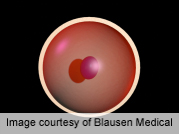
FRIDAY, Oct. 19 (HealthDay News) — A leading group of U.S. fertility doctors says there is now enough evidence to support the freezing of a woman’s eggs as a way to preserve fertility in young women.
Studies conducted over the past few years show that fertilization of frozen eggs has roughly the same success rate in terms of pregnancies and live births as in vitro fertilization using fresh eggs.
“We came to the conclusion that we really could not call this procedure experimental anymore, and we decided to lift that designation,” Dr. Samantha Pfeifer, chairwoman of the American Society for Reproductive Medicine (ASRM) practice committee, said at a news conference Wednesday. “As of the publication of this document, oocyte cryopreservation is no longer considered experimental, which is a huge advance compared to previous documents.”
The ASRM’s last statement on the matter, issued in 2008, deemed the practice still experimental. The new statement is published Oct. 22 in the journal Fertility and Sterility.
Researchers found almost 1,000 published papers on the topic of egg freezing — called oocyte cryopreservation — and selected the most relevant for analysis. They concluded that survival rates of the eggs, implantation rates and pregnancy rates are similar to those when using fresh eggs.
Much of this is due to the use of a new freezing technique called oocyte vitrification.
Because eggs contain a lot of water, slow-freezing ran the risk of producing ice crystals, which would damage the egg. Oocyte vitrification is essentially a flash-freezing technique, done after water has been extracted from the egg, which circumvents the problem of ice formations.
There does not appear to be any higher rate of birth defects among the 1,000 children born using this technique when compared to children born using fresh eggs or those born in the general population, according to the report.
Long-term data is limited, however, cautioned Dr. Eric Widra, chairman of the Society for Assisted Reproductive Technology practice committee.
“This is still a young technology,” he said. “The number of children born using this method is still small.”
By contrast, more than a million children have been born from in vitro fertilization using fresh eggs, he said.
The age of the woman at the time of treatment is paramount when predicting outcomes, Widra added. Few studies have looked at women beyond the age of 35 or 40, and younger women clearly have better success rates.
There just isn’t enough evidence supporting oocyte cryopreservation as an “elective” treatment for women who want to defer starting a family until later in life, Widra said.
The ASRM document said the technique could be used in couples that were looking at imminent infertility perhaps as a result of a medical issue, such as chemotherapy for cancer, or among couples undergoing in vitro fertilization that were having trouble collecting sufficient sperm.
“Eggs could be frozen at that point to allow future collection of sperm for fertilization,” Pfeifer said.
The procedure does carry some risks, such as the possibility of injury while eggs are being retrieved, and it is unclear if insurance would cover the cost of the procedure for certain groups of women, Pfeifer added.
More information
The American Society of Reproductive Medicine has more on infertility.

